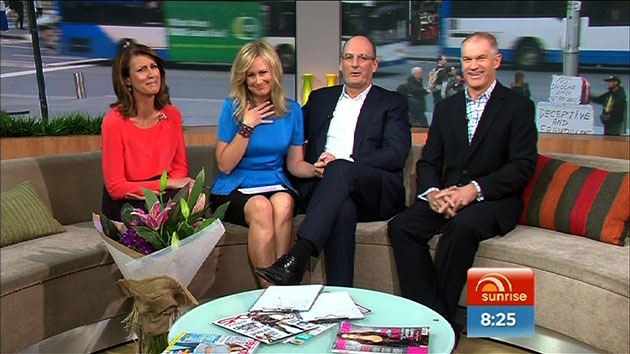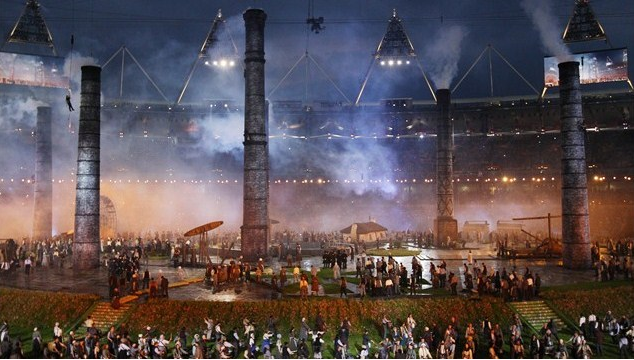Week Four: Live Television: The Extraordinary and the Everyday
Television is characterised by the notion and quality of live-ness, an important and powerful aspect in the integration of television with our lives organised around the technology. By dividing televisions ‘live’ content into ordinary and extraordinary programming, we can see the kind of work these types of television do in constituting times and spaces of collective experience for viewers, joining private and public life.
Everyday television can be seen as an example of how live-ness can simulate the existence of a close community, with shows being, “domesticated by television as if to attune the medium as a whole to the nuclear family, television’s original viewing group” (Dayan, D and Katz, E; 1994). In the morning audiences are vulnerable, tired and wishing we could get back to the bed we just left, the television therefore creates a type of comfort even though we might not be actively listening. The breakfast show Sunrise (2002) tries to fit seamlessly into our morning lives, as it does our private space. The studio is a familiar living room setting, with the news table used for important and more formal events, while the couch more informal discussion. The set design is made up of warm colours and the use of ornaments, such as drinks on the table, making the environment as unsterile and relatable as possible.

Though you don’t know them the hosts are the representation of people you’ve known your whole life, the occasionally rampage Kochie with his Dad jokes and laid back Australian attitude, who is kept in place by the motherly Mel who will steer the show back on course in times of astray, and the sub-hosts of the sports presenter and news reader, the children who really only speak when spoken to. The hosts constantly remind us of current events, and update those who’ve, “just joined us,” to capture any stray remote clickers that pass by. There is an element of intimacy as the hosts address you in a close way across time and space, but also remain distant to uphold authority. The show is run by their conversation, expressed in a colloquial tone and the content is presented in numerous mini-events as they transition between news and media.

With all these characteristics Sunrise tries to disguise itself as normality to our everyday lives, when in fact it is a media event. Through the show we can see television connect to the family form of social organisation; also achieving this in national terms as a crucial category of social identity. According to Benedict Anderson’s understanding of a nation defined as, “an imagined… community,” it’s noted that, “communities are to be distinguished, not by their falsity/genuineness, but by the style in which they are imagined,” always conceived as a deep, horizontal comradeship (Anderson, B; 1991). Television is an important technology in ‘conceiving’ this comradeship; keeping alive the idea we are a certain culture, our sense of belonging and national identity.
The London Olympics Opening Ceremony (2012) is a representation of extraordinary television, a media spectacle that acts to displace itself from the everyday to gain viewers. The Opening Ceremony, like other media events can be seen as a, “high holiday of mass communication,” where routine and the normal flow of broadcasting is interrupted to, “transform daily life into something special” (Dayan, D and Katz, E; 1994). These types of “programs… demand and receive focused attention,” providing, “an invitation – even a command – to stop… daily routines and join in a holiday experience” (Dayan, D and Katz, E; 1994). Dayan and Katz note these programs are characterised by the norm of viewing in which people tell each other that it is mandatory to watch, therefore “integrat[ing] societies in a collective heartbeat and evok[ing] a renewal of loyalty to the society and its legitimate authority” (Dayan, D and Katz, E; 1994).

The London Opening Ceremony added appeal with the, “unpredictability” (Levin, G; 2014) of the live event and the fact these moments were occurring in real time had the ability to, “transfix a nation or the world” (Dayan, D and Katz, E; 1994). Danny Boyle, the ceremony’s creative director, brought performative aesthetics to the ceremony, with elaborate sets, costumes and spectacles. The viewer is able to visually tell what they are watching is live from cues such as extras helping out and the OH&S officers on the side lines of the performance. Throughout the show commentators narrate on what’s happening, therefore you watch the show through the eyes of someone else, which here is British commentators speaking about what they see from a British perspective. This makes the content mediated by the commentators, as they appeal to a sense of British Nationalism and try to appeal to their audience demographic by tying in relevant concepts relevant to their heritage. However, the show acts to associate the world audience by drawing on concepts of industrial revolution, multiculturalism, British music and technological advancements which was all tied together with the internet. At the end of the sequence the infamous words of Tim Berners-Lee, inventor of the worldwide web, “This is for everyone!” is written across the audience, the word everyone ties in to all watching from across the world, promoting the fact that all this heritage has paved the path for the world we live in today.
The Opening Ceremony exhibits how audiences can immediately engage with an arrangement in a different country through the festivity of the media event we feel a part of something bigger, a broader society and collective, that at this moment sits around the television watching the spectacle.
References
Anderson, B 1991. Imagined communities: reflections on the origin and spread of nationalism, Verso, London & New York, pp. 1-9.
Dayan, D and Katz, E 1994. Media Events: The Live Broadcasting of History, Harvard University Press, United States of America.
Levin, G 2014. Live spectacles draw eyeballs to all screens, USA Today.
